Research Insights, May 09, 2022
Specialty Sectors Move to the Mainstream of Core Real Estate

Fundamental shifts in how we live and work are driving structural change in the profile of core real estate sectors, creating new areas of opportunity and paving the way for alternatives to serve a growing role. We explore key drivers that are helping propel self-storage, single-family rentals, and life science facilities as mainstays of modern core portfolios.
---
The list of real estate alternatives has grown considerably over the years. Whereas hotels, student, and senior housing were the primary domain of specialty property type investments prior to the Global Financial Crisis (GFC), today the definition has expanded to include single-family rentals (SFR), manufactured housing, medical office and life sciences, cold storage, data centers, and self-storage, and for some even extends into towers, infrastructure, and agricultural land.
These additions to the investable universe create greater opportunities to diversify income streams and ultimately enhance returns given the stronger relative demand outlook for certain specialty property types. This is particularly compelling considering some of the shifts underway in the more “core” property types like office and retail, which may drive reallocations in the coming years.
For investors contemplating what role specialty sectors should play in their core fund exposures, we believe the focus should be on identifying which are underpinned by structural and persistent tailwinds that can also act as additional “in-sector” diversifiers – for example, how single-family rentals and manufactured housing are synergistic with traditional multifamily in their function but cater to different demand forces and demographic cohorts, creating diversification under an expanded residential allocation.
While there are benefits and risks to each specialty property type, we believe the outlook for SFR, self-storage, life science, cold storage and data centers in particular suggests solid prospects for investors in the years to come, though limited transaction activity in cold storage and data centers will likely mean most of the opportunity will be concentrated in the former three.1
Less Core than Before
Historically, office and retail properties were considered vital core sectors given long lease terms, credit tenancy, and stabilized occupancy that insinuated lower risk and steady return profiles. Yet as we have seen over the course of the last decade, retail occupancies have continued to decline as the sector has struggled to adapt to the structural change resulting from the advent of e-commerce, making it harder and harder to outperform in a sector whose returns have lagged the NCREIF Property Index (NPI) by greater and greater margins (Figure 1).
The office sector appears to be facing its own reckoning in the wake of the pandemic. The necessity of the office as a critical component of corporate productivity has been called into question given the relative successes of mass work-from-home arrangements. From pre-pandemic peak (Q3 2019) to trough (Q3 2021), office occupancy had declined 347 basis points2; and while occupancy has improved 40 bps since the bottom, uncertainty remains. Renewals inked during the pandemic were predominately short-term extensions as companies lacked sufficient clarity on their future space needs to either commit to traditional longer-term leases or forego their space entirely. With many of these leases having been executed in 2020/early 2021, their term is quickly coming due – according to JLL, 242.5 million sf of office leases are expiring this year, the highest amount since 20153. Should demand stumble from its nascent recovery amidst elevated givebacks, occupancy – and the general profile of office in a core portfolio – would suffer.
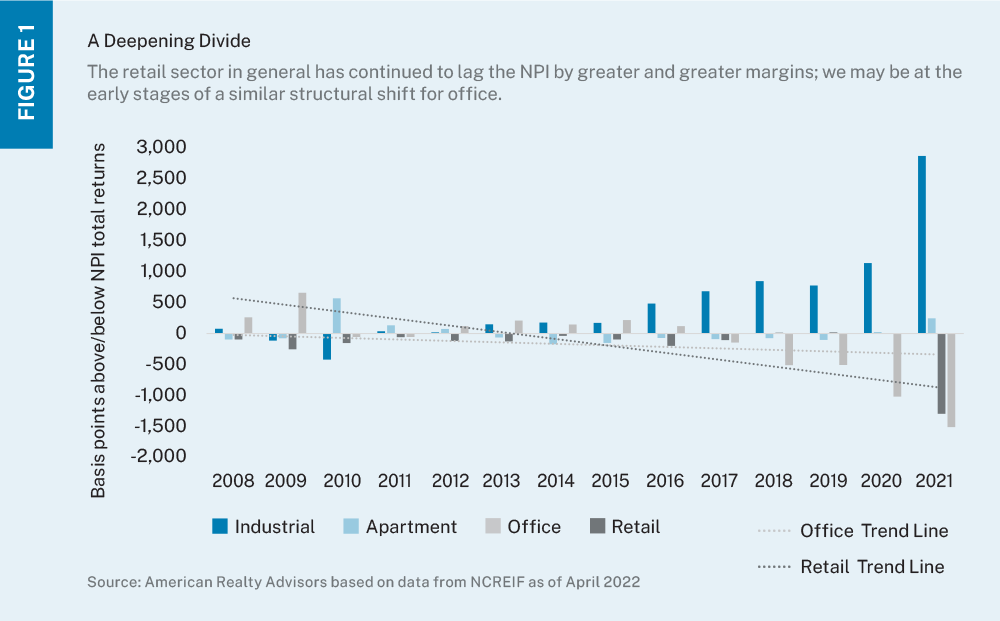
That’s not to say that there isn’t a place for office and retail in a core portfolio, or that there aren’t assets whose profiles continue to reflect core positionings; simply that there is likely to be more risk going forward in these sectors more broadly that leaves them feeling less core-like than before.
Maintaining Diversification
One of the many reasons ODCE funds have maintained such wide appeal is that they afford investors an opportunity to gain exposure to a variety of assets in different sectors and different markets, creating greater diversification than going at it alone on a direct asset-by-asset basis.
Yet with retail and office looking relatively less attractive, funds have been moving toward shrinking their holdings in these challenged sectors over the last couple of years. While a portfolio heavily oriented toward industrial (with the sector’s 43% unlevered total return in 2021), looks like a great bet, a full tilt to an industrial-and-multifamily-only portfolio significantly reduces the diversification offered to investors – not to mention risks exclusion from ODCE.4
This presents the challenge to core fund managers – if you aren’t inclined to the prospects being offered in office and retail, and you can’t invest exclusively in industrial and multifamily, where should you invest to optimize investment performance?
Follow the Change Agents
The driving principal behind our Change Agents series is the idea that real estate is fundamentally driven by two forces: growth, which begets more of the same, and change, which suggests transformation.
In our view, the emergence of specialty sectors as mainstream core-complements is a function of demographic and technological change. With change tailwinds firmly at the backs of single-family rentals (SFR), manufactured housing, self-storage, data centers, cold storage, and life science, we believe these areas are poised to continue to grow in prominence in diversified core portfolios. It is precisely for this reason that we’ve been actively orienting our portfolios in specialty sectors where the opportunity set is the deepest over the last two years.

Single-Family Rentals
Sector Drivers Summary:
- Sustained growth in 35-44-year-old age cohort
- Stunted earnings and student loan debt burdens preclude home purchases
- Unattainable for-sale housing prices for first-time buyers
- Need for more space to cater to growing families
Just as Millennials were a driving force behind the traditional multifamily boom of the last cycle, their entrance into the next phase of adulthood – evidenced by increased rates of marriage and child-bearing – begets a similarly deep opportunity. While nominal population in the young adult (25-34-year-old) cohort is slated to shrink beginning in 2023, the 35-44-year-old cohort is expected to grow given the size of the Millennial generation (Figure 2). Whereas historically this period would mark a transition into the for-sale market, climbing student loan burdens and earnings scarring from both the GFC and the pandemic have prevented a broader transition to home ownership that is further exacerbated by the recent run-up in prices and the added cost of higher interest rates.
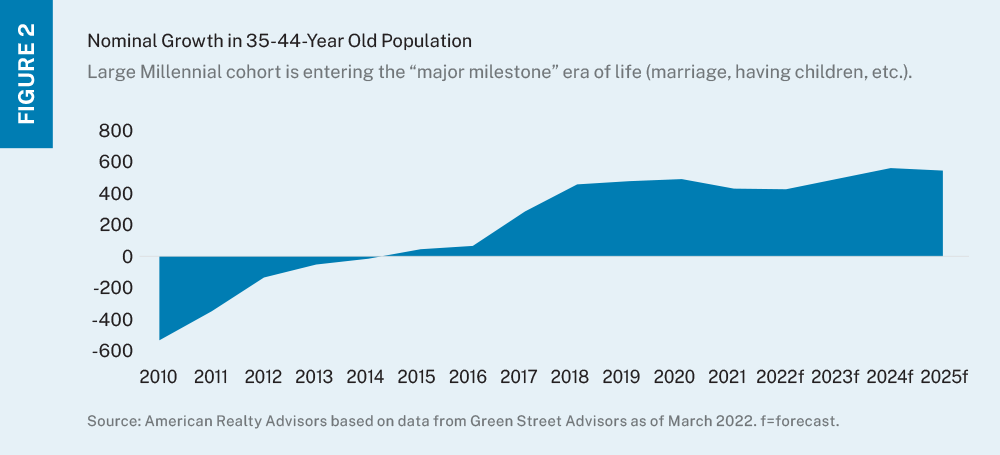
But the fundamental need of what a home provides remains, namely, more space. Driven by older Millennials’ desire and ability to work from home, the presence of children, and concerns surrounding urban school districts, purpose-built SFR is catering to that growing need (Figure 3) – all without the down payment plus closing cost hurdle (estimated to total at least 10% of purchase price) that has prevented more Millennial buyers from purchasing a home.
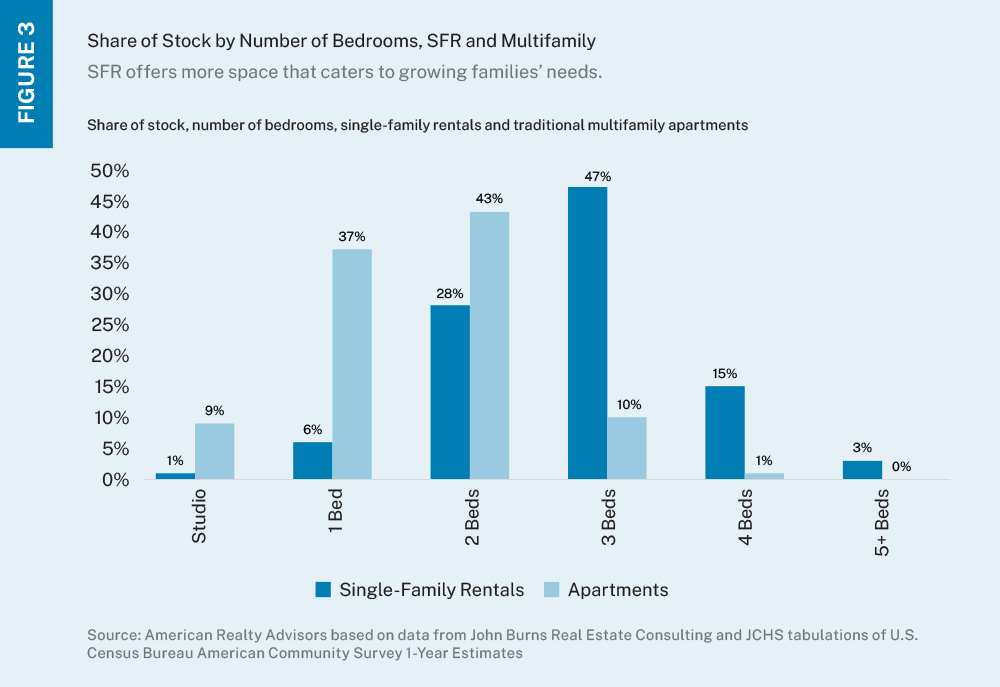
Buoyed by a sizable demographic wave and persistent headwinds to greater homeownership, we believe the runway for single-family rental is long. Unlike how others may be approaching the space, we are focused exclusively on buying and building purpose-built SFR communities – buying scattered homes on a one-off basis is an inefficient deployment of capital, and given the recent run-up in existing home prices, is not as competitive as being able to buy in bulk from home builders. We also view purpose-built communities as being a positive component of solving the housing shortage (given they are newly constructed and thus additive to existing stock) and less at risk of stoking the ire of local communities focused on preventing institutional capital from taking homes out of the hands of individual would-be buyers.

Self-Storage
Sector Drivers Summary:
- Moving-related needs
- Smaller home and apartment sizes over time
- De-cluttering to accommodate WFH
- Low relative operational intensity
If the pandemic accelerated anything at home, it was the need to re-envision spaces to serve multiple functions. Spare bedrooms, attics, garages, and basements that had previously served as usable space to store seasonal items like holiday décor and winter clothing were now needed to serve another function as dedicated work areas and home gyms. Yet the “stuff” remained.
For renters, the events of 2020 spurred moves: initially for younger renters, back in with mom and dad; then later, for older renters, an acceleration in a shift to the suburbs in search of more space. Among full-time workers, 16% moved between April 2020 and April 2021, up from 14% in 2019 and the first increase in residential mobility in over a decade5. And although moving activity is beginning to taper (by virtue of fewer available homes and apartments and a general stabilization in post-pandemic work trends), vacate activity has remained relatively muted compared to a normalized environment, suggesting this recent demand wave is “stickier.”6
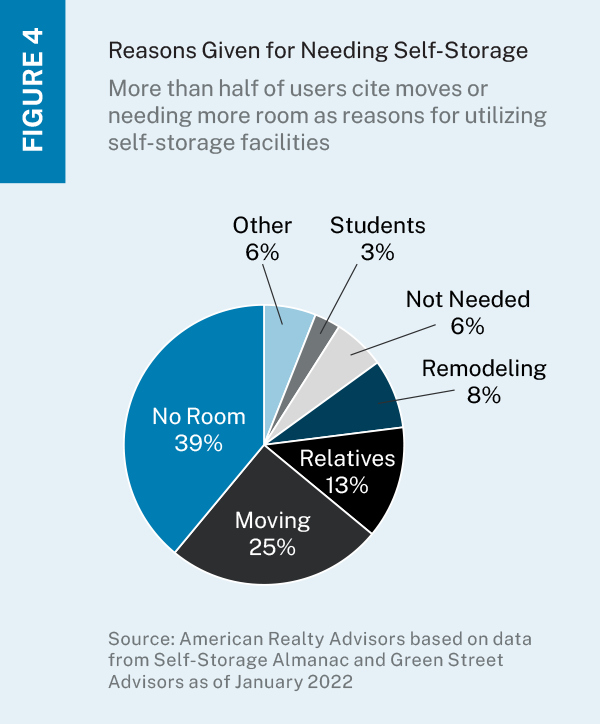 Downsizing, spring cleaning, lifestyle changes (such as divorce), and relocations – in effect, any period of “transition” – creates demand for self-storage (Figure 4). These demand factors have coalesced meaningfully in recent months, driving all-time high occupancies in the sector and accelerating the year-over-year change in Producer Price Index for self-storage facilities, which has historically exhibited a near-perfect correlation to rent growth (Figure 5).
Downsizing, spring cleaning, lifestyle changes (such as divorce), and relocations – in effect, any period of “transition” – creates demand for self-storage (Figure 4). These demand factors have coalesced meaningfully in recent months, driving all-time high occupancies in the sector and accelerating the year-over-year change in Producer Price Index for self-storage facilities, which has historically exhibited a near-perfect correlation to rent growth (Figure 5).
Historically, the self-storage sector has appealed to core investors given its relative resilience even during periods of economic disruption, though has been prone to bouts of oversupply in certain markets. Particularly compelling today is the sector’s ability to reset rents every 30 days without a correspondingly impactful rise in operational costs, which are generally low and fixed. Month-to-month leases offer more frequent opportunities for landlords to raise rates, offsetting term lockout in other sectors of a diversified core portfolio.
In our view, self-storage behaves as a sort of hybrid of traditional warehousing (via the storage of goods) and of the housing market more broadly. With both residential and industrial poised to continue to be the relative core outperformers, adding self-storage seems to be a particularly prudent way to double down on similar drivers while adding near-immediate inflation-hedging properties that only short-term leases can provide.
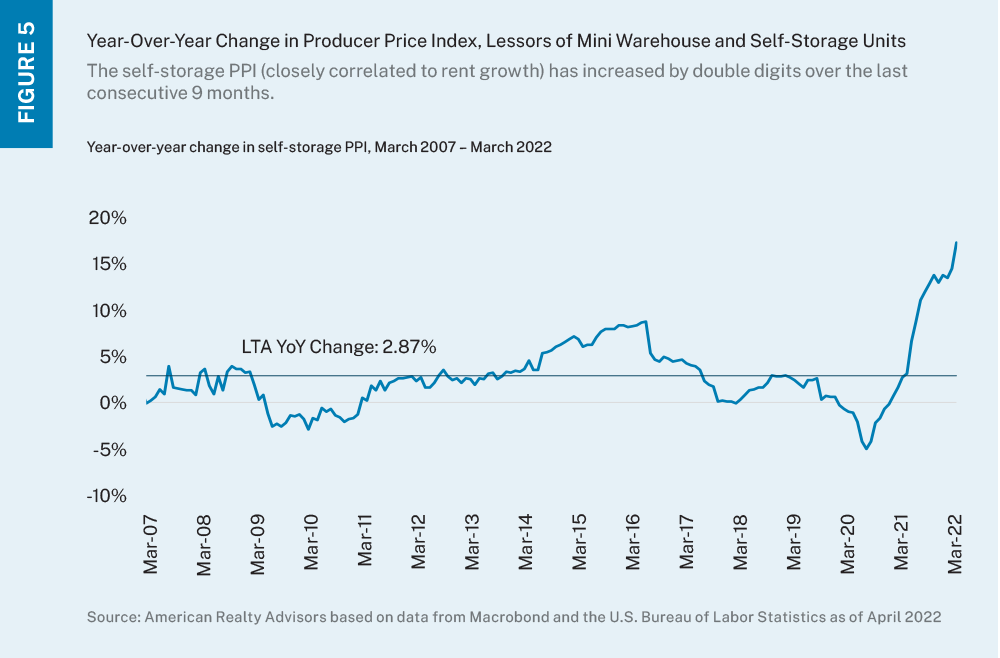

Life Sciences
Sector Drivers Summary:
- Ageing population
- Increased longevity
- Rise in public and private funding for research, pharmaceuticals
- Specialized spaces and sticky tenancy
The United States, like many other advanced economies, has transitioned from a population pyramid (whereby there are a greater number of young people supporting a smaller relative number of elderly) to that of a pillar (Figure 6). Over the next 20 years, the number of people in the U.S. over the age of 50 will increase by 24.5 million people, while the cohort under 50 is expected to increase by only 5.6 million.
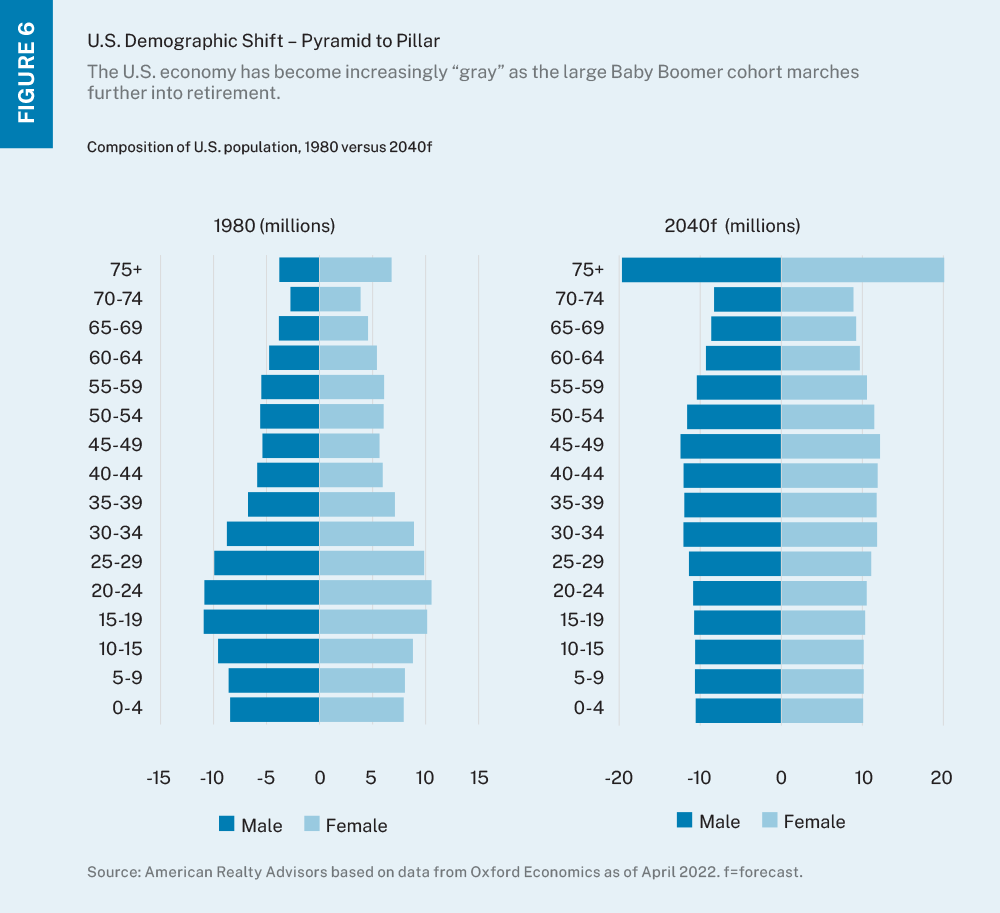
As an economy, this has meant a downtrend in the overall pace of GDP growth (as consumer spending tends to lessen as people age) but has also created higher levels of need for healthcare and medical services to serve a large and growing segment of the population.
Older adults are disproportionately affected by chronic conditions that require treatment; this, plus increases in longevity also means that subsequent generations will have a need for biotech and pharmaceutical solutions for longer periods of their lives – according to current projections from the Social Security Administration, a man born in the year 2000 has an average life expectancy of 81.1 years, a female, 85 years.
Life sciences has been one of the fastest-growing segments of the economy in recent years given this demographic impetus, with life sciences-related employment growth three times stronger than that of the U.S. over the last decade. Historic amounts of funding continue to flow into the sector too – venture capital (VC)funding into U.S. healthcare totaled $72.4 billion in 2021, representing a 64.3% year-over-year increase (Figure 7). This is in addition to the roughly $41.7 billion invested annually by the National Institutes of Health in medical research and the more than $100 billion annually from biopharma research and development expenditures, has led to meaningful uptake in space that can accommodate the highly specialized life sciences operations.
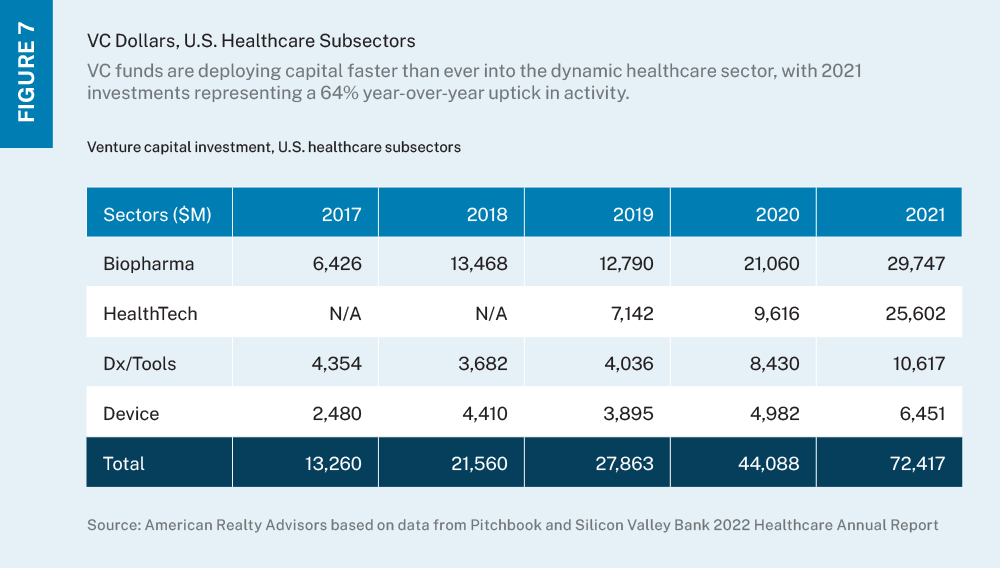
Life sciences real estate is highly specialized given the specific accommodations required. The multidimensional work that takes place in labs means the spaces are highly customized with zones for different functions, such as wet labs, workstations, areas for collaboration, and dedicated technology spaces. As a result, tenant buildouts are often extensive, which makes the effort and cost to relocate to another property particularly onerous, resulting in stickier tenancies and higher renewal probabilities.
Roughly 50% of life science space utilization by tenants historically has been dedicated to functions that are not lab space, and today, there is a trend toward even greater collaboration and idea generation space with less wet lab space, making it even more akin to core office, but with a more compelling supply-demand backdrop.
Conclusion
As managers work to reposition portfolios to align with where demand is headed, this is expected to result in further reductions in office and retail holdings overall; what replaces these allocations is likely to drive the next generation of relative core fund winners and losers.
Shifting technological and demographic forces accelerated by the pandemic are driving the creation of new scalable areas of growth for real estate investors, though not all specialty sectors are created equal in their ability to enhance returns.
We believe the specialty sectors that offer the strongest long-term investment opportunities are those that
A) are underpinned by structural "beds, sheds and tech" tailwinds,
B) have functional synergies with existing allocations such that managing the day-to-day operations is within the asset manager's wheelhouse, and
C) whose demand is derived from different sources, improving fund- and intra-sector diversification.
---
Notes
1 While cold storage and data centers could also feasibly be included as core fund specialty sector targets given our criterion, the limited transaction and construction activity coupled with high speculative development costs suggest the overall opportunity set is rather more limited such that they are likely to comprise much smaller allocations, though are viewed as being generally additive in the event they become available more widely.
2 Source: NPI Trends Report for 4Q 2021.
3 Source: Wall Street Journal, “Record High Office Lease Expirations Pose New Threat to Landlords and Banks”, April 12, 2022 with data from JLL.
4 For inclusion in ODCE, funds are allowed a maximum concentration in any one property type of 60% of GAV and must invest in three of the four major property types with a 5% GAV minimum in each.
5 Source: ApartmentList based on data from the Census ACS accessed using IPUMS.
6 Source: Green Street Advisors Self-Storage Sector Update – March 9, 2022.
Disclaimer
The information in this newsletter is as of May 3, 2022, and is for your informational and educational purposes only, is not intended to be relied on to make any investment decisions, and is neither an offer to sell nor a solicitation of an offer to buy any securities or financial instruments in any jurisdiction. This newsletter expresses the views of the author as of the date indicated and such views are subject to change without notice. The information in this newsletter has been obtained or derived from sources believed by ARA to be reliable but ARA does not represent that this information is accurate or complete and has not independently verified the accuracy or completeness of such information or assumptions on which such information is based. Models used in any analysis may be proprietary, making the results difficult for any third party to reproduce. Past performance of any kind referenced in the information above in connection with any particular strategy should not be taken as an indicator of future results of such strategies. It is important to understand that investments of the type referenced in the information above pose the potential for loss of capital over any time period. This newsletter is proprietary to ARA and may not be copied, reproduced, republished, or posted in whole or in part, in any form and may not be circulated or redelivered to any person without the prior written consent of ARA.
Forward-Looking Statements
This newsletter contains forward-looking statements within the meaning of federal securities laws. Forward-looking statements are statements that do not represent historical facts and are based on our beliefs, assumptions made by us, and information currently available to us. Forward-looking statements in this newsletter are based on our current expectations as of the date of this newsletter, which could change or not materialize as expected. Actual results may differ materially due to a variety of uncertainties and risk factors. Except as required by law, ARA assumes no obligation to update any such forward-looking statements.

